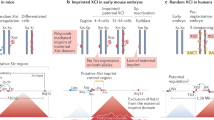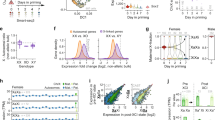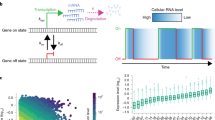Abstract
X-chromosome inactivation results in the cis-limited dosage compensation of genes on one of the pair of X chromosomes in mammalian females. Although most X-linked genes are believed to be subject to inactivation, several are known to be expressed from both active and inactive X chromosomes. Here we describe an X-linked gene with a novel expression pattern—transcripts are detected only from the inactive X chromosome (Xi) and not from the active X chromosome (Xa). This gene, called XIST (for Xi-specific transcripts), is a candidate for a gene either involved in or uniquely influenced by the process of X inactivation.
This is a preview of subscription content, access via your institution
Access options
Subscribe to this journal
Receive 51 print issues and online access
$199.00 per year
only $3.90 per issue
Buy this article
- Purchase on Springer Link
- Instant access to full article PDF
Prices may be subject to local taxes which are calculated during checkout
Similar content being viewed by others
References
Lyon, M. F. Biol. Rev. 47, 1–35 (1972).
Gartler, S. M. & Riggs, A. D. A. Rev. Genet. 17, 155–190 (1983).
Lyon, M. F. Nature 190, 372–373 (1961).
Russell, L. B. Science 140, 976–978 (1963).
Cattanach, B. M. A. Rev. Genet. 9, 1–18 (1975).
Migeon, B. R., der Kaloustian, V. M., Nyhan, W. L., Young, W. J. & Childs, B. Science 160, 425–427 (1968).
Meyer, W. J., Migeon, B. R. & Migeon, C. J. Proc. natn. Acad. Sci. U.S.A. 72, 1469–1472 (1975).
Davidson, R. G., Nitowsky, H. M. & Childs, B. Proc. natn. Acad. Sci. U.S.A. 50, 481–484 (1963).
Schneider-Gadicke, A., Beer-Romero, P., Brown, L. G., Nussbaum, R. & Page, D. C. Cell 57, 1247–1258 (1989).
Fisher, E. et al. Cell 63, 1205–1218 (1990).
Nadon, N., Dorn, N. & DeMars, R. Somat. Cell molec. Genet. 14, 541–552 (1988).
Graves, J. A. M. & Gartler, S. M. Somat. Cell. molec. Genet. 12, 275–280 (1986).
Brown, C. J., Flenniken, A., Williams, B. & Willard, H. F. Nucleic Acids Res. 18, 4191–4195 (1990).
Shapiro, L. J., Mohandas, T., Weiss, R. & Romeo, G. Science 204, 1224–1226 (1979).
Goodfellow, P., Pym, B., Mohandas, T. & Shapiro, L. J. Am. J. hum. Genet. 36, 777–782 (1984).
Brown, C. J. & Willard, H. F. Am. J. hum. Genet. 46, 273–279 (1990).
Brown, C. J., Barker, D. & Willard, H. F. Am. J. hum. Genet. 45, A178 (1989).
Ballabio, A. et al. Proc. natn. Acad Sci. U.S.A. 84, 4519–4523 (1987).
Brown, C. J. et al. Nature 349, 82–84 (1991).
Migeon, B. R., Sprenkle, J. A. & Do, T. T. Cell 18, 637–641 (1979).
Willard, H. F. & Breg, W. R. Somat. Cell Genet. 6, 187–188 (1980).
Shapiro, M. B. & Senapathy, P. Nucleic Acids Res. 15, 7155–7175 (1987).
Frohman, M. A., Dush, M. K. & Martin, G. R. Proc. natn. Acad. Sci. U.S.A. 85, 8998–9002 (1988).
Fickett, J. W. Nucleic Acids Res. 10, 5303–531 (1982).
Mattel, M. G., Mattel, J. F., Vidal, I. & Giraud, F. Hum. Genet. 56, 401–408 (1981).
Summitt, R. L., Tipton, R. E., Wilroy, R. S. Jr., Martens, P. & Phelan, J. P. Birth Defects: Orig. Art. Ser. 14, 219–247 (1978).
Therman, E., Sarto, G. E. & Patau, K. Chromosoma 44, 361–366 (1974).
Fiejter, W. L., Van Dyke, D. L. & Weiss, L. Am. J. hum. Genet. 36, 218–226 (1984).
Rastan, S. J. Embryol. exp. Morph. 78, 1–22 (1983).
Rastan, S. & Robertson, E. J. J. Embryol. exp. Morph. 90, 379–388 (1985).
Johnston, P. G. & Cattanach, B. M. Genet. Res. 37, 151–160 (1981).
Rastan, S. Genet Res. 40, 139–147 (1982).
Brown, S. W. & Chandra, H. S. Proc. natn. Acad. Sci. U.S.A. 70, 195–199 (1973).
Riggs, A. D. Aust. J. Zool. 37, 419–441 (1990).
Lyon, M. F. et al. J. Embryol. exp. Morph. 97, 75–85 (1986).
Keer, J. T. et al. Genomics 7, 566–572 (1990).
Chirgwin, J. M. et al. Biochemistry 18, 5294–5299 (1979).
Brown, C. J. & Willard, H. F. Am. J. hum. Genet. 45, 592–598 (1989).
Grompe, M., Muzny, D. M. & Caskey, C. T. Proc. natn. Acad. Sci. U.S.A. 86, 5888–5892 (1989).
Korneluk, R. G., Quan, F. & Gravel, R. A. Gene 40, 317–323 (1985).
Gibbs, R. A., Nguyen, P.-N., McBride, L. J., Koepf, S. M. & Caskey, C. T. Proc. natn. Acad. Sci. U.S.A. 86, 1919–1923 (1989).
Author information
Authors and Affiliations
Rights and permissions
About this article
Cite this article
Brown, C., Ballabio, A., Rupert, J. et al. A gene from the region of the human X inactivation centre is expressed exclusively from the inactive X chromosome. Nature 349, 38–44 (1991). https://doi.org/10.1038/349038a0
Received:
Accepted:
Issue Date:
DOI: https://doi.org/10.1038/349038a0
This article is cited by
-
X chromosome inactivation skewing is common in advanced carotid atherosclerotic lesions in females and predicts secondary peripheral artery events
Biology of Sex Differences (2023)
-
LncRNA XIST regulates breast cancer stem cells by activating proinflammatory IL-6/STAT3 signaling
Oncogene (2023)
-
GATA transcription factors drive initial Xist upregulation after fertilization through direct activation of long-range enhancers
Nature Cell Biology (2023)
-
Non-coding RNAs in disease: from mechanisms to therapeutics
Nature Reviews Genetics (2023)
-
Unconventional roles of chromatin remodelers and long non-coding RNAs in cell division
Cellular and Molecular Life Sciences (2023)
Comments
By submitting a comment you agree to abide by our Terms and Community Guidelines. If you find something abusive or that does not comply with our terms or guidelines please flag it as inappropriate.



